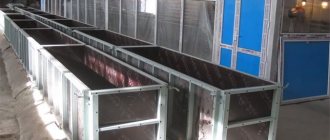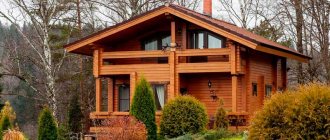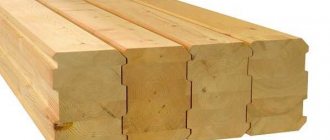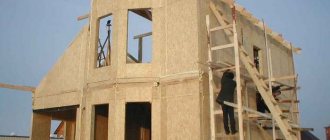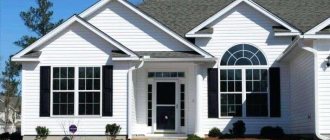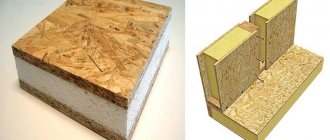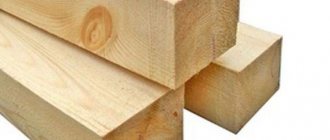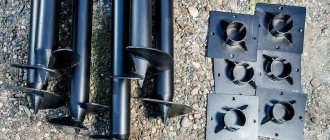Glued laminated timber occupies a significant share of the domestic wooden house-building market. What is the reason for this, what is laminated timber, what characteristics and properties does it have, what are the advantages and disadvantages, we will consider in this article.
Glued laminated timber - technical characteristics
Wood has always been, is and for a long time will be the most harmless building material. Accordingly, wooden houses will always be in demand. However, the level of sales is affected by the natural shortcomings inherent in wood, among the most important: cracking, torsion, biological instability. These qualities, one way or another, manifest themselves in any building material during a certain period of operation of the building constructed from it. To level out or reduce the likelihood of some of them, new technologies are being introduced, such as laminated veneer lumber.
Glued laminated timber - what is it?
Glued laminated timber is a technologically advanced lumber that consists of boards (lamellas) glued together and, after profiling, is a stable wooden beam with improved performance characteristics. Material prepared for the website www.moydomik.net
We recommend : what is the difference and what is better, laminated or profiled timber made of solid wood.
Glued laminated timber production technology
To understand what is special about laminated timber, you need to briefly consider how this type of material is made:
- choice of wood .
Coniferous wood is usually used to make laminated veneer lumber. Pine and spruce are more resistant to the external environment, accessible and easy to process. There is glued laminated timber made from hardwood, but its cost is much higher. The most popular breeds are:
- cedar _ Advantages: the presence of essential oils that create a unique microclimate in the house, resistance to external factors, durability, disinfecting properties. The only drawback is the significant price;
- spruce _ Features: slightly less strength compared to pine, good soundproofing properties, warm yellow color. Glued laminated spruce timber is in the same price category as pine timber;
- pine . Advantages: strength, availability, low cost, beautiful structure. Glued laminated pine timber accounts for the largest share in sales of this material. Disadvantages include the presence of knots and resin pockets. But the manufacturing technology of laminated veneer lumber allows them to be cut and only high-quality pieces of wood can be used in the future;
- larch . Pros: increased resistance to external influences, durability, beautiful appearance. Due to the significant cost of larch, only the external lamellas of the timber are made from it. Limitations include: increased resin content (complicates processing and increases the likelihood of weak bonding), low air permeability, and relatively high price. Glued laminated larch timber is one and a half times more expensive than pine timber;
- oak _ It is durable and reliable. But the complexity of processing and the high cost of wood do not allow us to establish stream production of laminated oak timber, only to order. As a rule, the outer lamellas of the timber are made from oak. Only large manufacturers with special equipment undertake to work with oak.
Note. From the point of view of operation, the front lamella is important, therefore, a combined adhesive beam is available on the market, in which the outer lamellas are made of larch, and the inner ones are made of pine.
- sawing logs into boards . Small manufacturers purchase ready-made lumber;
- calibration _ There is no rejection at this stage, as such. This is because the slats can be cut and removed, and then glued together. Calibration involves sorting workpieces depending on size;
- drying _ Drying can be done under natural conditions and in special chambers. More often, chamber drying is preferred, because... the board is thinner than a solid beam and will not move during the drying process;
- processing on a four-sided machine to reveal defects;
- sorting workpieces by strength . There are manual and machine sorting. Machine is preferable because better determines the strength characteristics of lamellas;
- milling _ Provides for the production of a toothed profile. The smaller the thickness of the workpiece, the finer the profile teeth;
- gluing along the length . One of the features of laminated veneer lumber is that there is no limitation on the length of the material (unlike profiled timber, the maximum length of which is 6 meters);
- thicknessing . Allows you to make the plane of the lamella smooth;
- applying glue . Melamine, resorption, polyurethane adhesives, EPI systems are used, with different classes of water resistance and environmental safety. The adhesive system is subject to mandatory certification;
- pressing . Since laminated veneer lumber is a set of lamellas, it is possible to vary the cross-section of the timber in a wide range while maintaining the characteristics. Glued laminated timber 200x200 has the same properties as timber 150x100 or another size. While it is quite difficult to dry dry profiled timber with a cross-section of 200x200 without any problems;
- profiling;
- trim;
- cutting out landing cups (grooves).
In practice, for the construction of a log house, a ready-made house kit made of laminated veneer lumber is ordered, which is manufactured in accordance with the project. This approach makes it possible to obtain a set of timber, according to the principle of a designer, which is already cut into beams of the required length, has landing cups and holes for dowels/pins, as well as communications, etc., treated with antiseptics, marked and packaged.
Which material is better: larch, cedar or pine?
The following types of wood can be used in the production of the material:
- pine;
- spruce;
- larch;
- cedar;
- fir.
The strength of the finished material depends on the type of wood: larch and cedar are of elite quality, spruce is durable, but pine is superior to it, especially northern pine.
Siberian cedar is the highest quality material for the production of laminated timber in Russia, but its cost is significantly higher than pine products.
The most common is the production of pine laminated timber, as it is available in many regions of Russia and costs less than other types of wood.
- Pine is the most common building material. It is easily processed, resistant to cracking and durable. Due to its properties, pine is practically not affected by fungus.
- Larch. The main feature of larch is the absence of rot, since it is not exposed to water. The material is carefully processed beforehand.
It was from this tree that the building material was used to construct the foundations of buildings in Venice.
- Cedar is a very valuable type of building material. The wood of this tree is quite expensive; in most cases it is used for interior decoration.
Technical characteristics and dimensions of laminated veneer lumber
Glued laminated timber can be divided into types according to three classification criteria:
| № | Sign | Detailing |
| 1 | Linear parameters | – length up to 18,000 mm; – cross-section from 80 to 360 mm. |
| 2 | Front view | – square with angles of 90°; – curved (D-shaped); – curved (O-shaped). |
| 3 | Number of lamellas in timber | – from two to ten (in the salon beam). |
| 4 | Bonding technology | – horizontal. The slats are connected in a horizontal plane. Did not receive recognition in Russia; – vertical. The slats are connected in a vertical plane. Most common; – salon. Consists of two blocks of lamellas. First, the lamellas in the blocks are glued vertically, and then the blocks are glued horizontally. |
| 5 | Profiling type | – under thermal insulation material; – does not require laying thermal insulation material. |
| 6 | Profile view | – comb (in different variations); – Finnish (in different variations). Glued laminated timber is profiled using the same equipment as profiled solid timber, but there are more varieties within each type of profile. |
Types of profiles and dimensions of laminated veneer lumber (width, height), vertical and horizontal laminated veneer lumber
Classification of building material
Glued laminated timber is produced with different types of profiles and distinctive design features. The type of building material is selected based on its application.
Types of timber by purpose
According to their intended use, laminated laminated timber is divided into three groups:
- Wall. The edges of such lumber are smooth, and tenons are provided for strong joining of elements. The main purpose is the construction of house walls.
- Window and door. The material is used in the production of furniture, doors and windows .
- Support. Durable beams for the construction of frames for stairs and roofs, load-bearing supports for half-timbered houses, etc.
The last two options for lumber in cross-section are rectangular or square, without cutouts .
Building material profile: comb and Finnish
Based on the shape of the profile, two types of lumber are distinguished:
- comb;
- Finnish.
The comb at the top and bottom of the beam has rectangular teeth, ensuring reliable joining of the laying elements . If the material is of poor quality, the grooves may not match and you will have to spend a lot of time adjusting them.
The profile of Scandinavian lumber has a tongue-and-groove pattern along the edges and a recess in the center. This structure allows the use of inter-crown insulation for laminated veneer lumber . From the outside, the layer of thermal insulation will be invisible.
A house made of Scandinavian timber is warmer. Since the walls have to be caulked less, the construction time is accelerated.
Design features of timber
To assemble the walls, various types of beams are used, which differ in design. Three groups of lumber can be distinguished:
- uninsulated;
- insulated;
- bent.
Glued laminated timber with insulation inside allows you to speed up installation work , since you do not have to install additional thermal insulation. However, the price for it is significantly higher than for non-insulated lumber. If the thickness of the timber and the weather conditions of the region allow you to do without insulation, then it is more advisable to buy ordinary non-insulated material.
You cannot do without a bent option when constructing structures of complex shapes: arches, stairs with bends, etc. The disadvantage of such timber is the high price . The cost of bent lumber can be twice the price of straight timber of the same cross-section.
Section dimensions of different types of beams:
- load-bearing beams – 300 mm;
- window bars – 80-90 mm;
- door lumber – up to 120 mm;
- wall without insulation – 100-180 mm;
- insulated timber – up to 270 mm.
How to make laminated veneer lumber with your own hands
To make homemade timber you will need: a hacksaw, a plane, clamps, a grinder, glue, brushes and boards.
Operating procedure:
- dry the boards. In home production, natural drying is used. It is better to load the boards so that they do not twist;
- treat dry boards with an antiseptic and dry;
- treat the front surfaces: sand and degrease;
- fold the boards and evaluate the appearance of the timber (thickness, geometry, etc.);
- apply glue;
- fold the slats and secure them with clamps;
- Then the final processing of the timber is carried out: trimming, profiling, cutting bowls, drilling, etc.
Advantages and disadvantages of laminated timber
Glued laminated timber boasts a number of advantages and only a few disadvantages.
The main feature of laminated veneer lumber is that to form the front side of the veneer lumber, not only a more durable type of wood is used, but also the hardest part of the tree - its core. Heartwood is less susceptible to warping and cracking than heartwood, which, as the softest part of the wood, is removed from the edge and placed between the face slats. This is the so-called Finnish standard. In the practice of domestic production, not all manufacturers meet this requirement, so the properties of laminated veneer lumber do not always correspond to the declared ones.
Let's look at the pros and cons.
Advantages of laminated timber:
- aesthetics. Glued laminated timber combines the beauty of wood and the high quality of processing of the lamellas;
- naturalness. Many argue that the presence of glue does not allow laminated veneer lumber to be classified as an environmentally friendly material. However, glue is subject to mandatory certification, and only adhesive compositions that meet safety requirements are used for construction;
- crack resistance. Glued laminated timber has a minimum number of cracks due to two factors. Firstly, thin lamellas are easier to dry throughout the entire volume. Secondly, due to the glue they are more durable. And the likelihood of through cracking is generally absent;
- stability of geometric dimensions. Glued laminated timber does not lead, regardless of operating conditions;
- high load-bearing capacity with low weight;
- no restrictions in the implementation of the project. Glued laminated timber allows you to create complex shapes, bent shapes, and build long walls without partitions or merging of timber;
- the ability to combine walls of different thicknesses in one project;
- minimum shrinkage, which is 0.4-1.5% over the entire period of operation of the building;
- ease of installation, the assembly of a house from laminated veneer lumber can be carried out in any weather, at any time of the year;
- the opportunity to immediately move into a built house or begin finishing it;
- increased thermal insulation performance;
- resistance to biological activity;
- predicted strength indicators.
Disadvantages of laminated timber
- the high cost of laminated veneer lumber compared to profiled kiln-drying timber, as well as other wood materials;
- the likelihood of delamination of the lamellas if the production or gluing technology is violated, which entails a decrease in the properties of the timber;
- risk of buying counterfeit goods;
- the need for regular care. But this requirement is made by all houses built of wood.
The price of laminated timber depends on several factors:
- section;
- wood species;
- transportation cost.
Approximate prices for laminated pine timber per cubic meter. are given in the table
Technological conditions
It is made by gluing lamellas, spliced along the length onto a toothed tenon from blanks with a length of 450 to 1900 mm, a thickness of no more than 50 mm, with waterproof glue based on urea-melamine resins with separate application of components to the surfaces to be glued.
Common parameters:
| Parameter | Meaning | Maximum deviation |
| Timber material | Fur tree, pine tree | Grade 0-3 (GOST 8486-86) |
| Beam height, mm | 94-194 | +/- 2 |
| Beam width, mm | 80-300 | +/-1 |
| Beam length, mm | Up to 14000 | +/-5 |
| Tenon height, groove depth, mm | 10-20 | +/-1 |
| Humidity, % | 10 | +/-2 |
| Surface roughness, microns | 100 | — |
| Strength of adhesive joints during layer-by-layer chipping, not less, MPa* | 5 | + |
| Strength of toothed adhesive joints, not less, MPa | 27 | + |
| Glue joint thickness, mm | 0,5 | — 0,35 |
| Hole diameter dimensions, mm | — | +/-0,2 |
| Center-to-center dimensions, mm | — | +/-0,5 |
* When fractured through wood, the strength of the connection is determined by the strength of the wood and the test results are considered positive.
Requirements for the quality of blanks of internal layers:
| Vices | Layer restrictions* |
| The knots are healthy, fused, light-colored with cracks | Allowed |
| Black knots, unfused | Allowed |
| Rotten, fallen, tobacco knots, sprouting | Allowed |
| Branched knots | Allowed |
| Through cracks | Not allowed |
| End-to-end cracks | Allowed |
| Non-through face cracks | Allowed |
| Resin pockets, tar on the surfaces | Allowed |
| Rotten | Not allowed |
| The core is opened | Allowed |
| Wane acute | Not allowed |
| Wane is blunt | Allowed, width no more than 15 mm. |
| Blue, sapwood colors | Allowed |
| Unproportional on the surface | Not allowed |
* In quantity and size according to tolerances 3 grades GOST 8486-86
- — The location of the knot from the edge of the workpiece at the place where the tenon is cut must be at least 50 mm.
- — Non-gluing of timber layers is not allowed.
- — The gap at the joints of spliced lamellas is no more than 1 mm.
2.2 Grade of timber (according to the quality of outer layers)*
The grade of timber is determined by its aesthetic characteristics:
“Extra” grade – it is assumed that it can be used without decorative cladding.
“Standard” grade – the use of decorative cladding on the outside and inside.
At the customer's request included in the contract, the outer layers can be formed from wood of the same species composition.
*Note: the strength and thermophysical characteristics of all grades are identical.
| № | Vices | Variety Extra | Variety Standard* |
| 1 | The knots are healthy, fused, light-colored with cracks | No more than 3 pieces per 1 running meter are allowed. diameter up to 35mm | Allowed |
| 2 | Black knots, unfused | No more than 2 pieces per 1 linear meter are allowed. diameter up to 20mm | Allowed |
| 3 | Rotten, fallen, tobacco knots, sprouting | Not allowed | Allowed |
| 4 | Branched knots | Not allowed on the front side of the outer lamella | Allowed |
| 5 | Through cracks | Not allowed | |
| 6 | Non-through cracks 2-4mm wide | No more than 1 piece is allowed. length up to 1/3 of the workpiece | Allowed |
| 7 | Resin pockets, tar on the surfaces | Not allowed | Allowed |
| 8 | The core is opened | Not allowed | Allowed |
| 9 | Obzol | Not allowed | |
| 10 | Blue, sapwood colors | Not allowed | Allowed |
| 11 | Unproportional on the surface | Not allowed | Allowed |
* In quantity and size, respectively, tolerances are 3 grades GOST 8486-86
New on the market
Glued laminated timber, despite its inherent high performance characteristics, is constantly being improved. Thus, new materials have appeared on the domestic market that have even more improved properties.
Insulated laminated timber
One of them is innovative insulated laminated veneer lumber (). Its peculiarity is the presence of a seal in the upper part of the profile, which eliminates the flow of water, reduces the degree of blowing, and increases the soundproofing properties of the wall.
Triple beam
The second material can be called “triple timber”. This is more likely not a material, but a construction technology, which involves the installation of several boards with a section of 180x60 in a special patented method. The boards are glued together directly during the construction process, resulting in a strong monolithic wall. This approach makes it possible to eliminate the appearance of through cracks and blowing due to the displacement of the boards.
Triple laminated timber technology
What to look for when buying laminated timber:
- gluing type;
- number of lamellas for the same timber thickness;
- availability of a certificate for the adhesive composition;
- quality of the front sides of the timber;
- presence of trim and its quality;
- reviews about the place of sale (manufacturers, seller, etc.);
- Possibility to order a house kit.
Guided by these factors and strictly following the technology of construction from laminated veneer lumber, we can safely say that a house made of timber will serve more than one generation of users. The main thing is to provide it with proper care and timely treatment with special impregnations to prevent color changes and increased aging.
How to choose material for your home
When choosing timber from glued boards for your home, the main attention should be paid to:
- Absence of wane (bark) on the lamellas, uneven cuts and cuts;
- The quality of drying and gluing of boards;
- Correct geometry - all planes of the profiled timber must be smooth and polished, otherwise the building may turn out crooked;
- Type of construction - wall and support products have fundamentally different purposes.
The thinner the lamellas are used for gluing, the higher the strength characteristics of the laminated timber will be and the more durable the house will be. Water should not be a problem for this lumber. Moisture is harmful to wood, but the adhesive layer between the timber boards has no right to collapse. If the lamellas delaminate, then the manufacturer produced a defect by using unsuitable glue.
Dimensions
In Russia, when producing lumber for laminated timber houses, adhesives based on melamine or polyurethane are used. By definition, they do not contain phenol, and if there is formaldehyde, it is in minimal quantities. There is no need to fear for the health of your family, as is often written about on forums.
The source of formaldehyde and phenolic fumes should be sought elsewhere. There are always plenty of different finishing materials in log houses. They are most likely the ones emitting harmful substances. Linoleums, non-woven wallpaper, paintwork materials - you need to look for the cause of strong odors in them.
But all this concerns exclusively high-quality material. Before purchasing laminated veneer lumber, you must ask the seller for a certificate indicating all the characteristics of the product. You should purchase this building material only from manufacturers who use high-quality glue in production. This will guarantee the absence of both phenol in a private cottage and defects in lumber.

